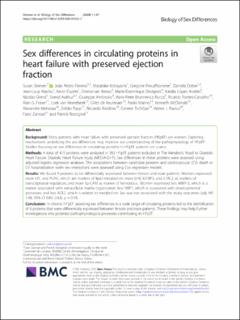| dc.contributor.author | Stienen, Susan | |
| dc.contributor.author | Ferreira, João Pedro | |
| dc.contributor.author | Kobayashi, Masatake | |
| dc.contributor.author | Preud'homme, Gregoire | |
| dc.contributor.author | Dobre, Daniela | |
| dc.contributor.author | Machu, Jean-Loup | |
| dc.contributor.author | Duarte, Kevin | |
| dc.contributor.author | Bresso, Emmanuel | |
| dc.contributor.author | Devignes, Marie-Domique | |
| dc.contributor.author | Lopez-Andres, Natalia | |
| dc.contributor.author | Girerd, Nicolas | |
| dc.contributor.author | Aakhus, Svend | |
| dc.contributor.author | Ambrosio, Giuseppe | |
| dc.contributor.author | Brunner-La Rocca, Hans-Peter | |
| dc.contributor.author | Fontes-Carvalho, Ricardo | |
| dc.contributor.author | Fraser, Alan G. | |
| dc.contributor.author | de Keulenaer, Gilles | |
| dc.contributor.author | Marino, Paolo | |
| dc.contributor.author | McDonald, Kenneth | |
| dc.contributor.author | Mebazaa, Alexandre | |
| dc.contributor.author | Papp, Zoltan | |
| dc.contributor.author | Raddino, Riccardo | |
| dc.contributor.author | Tschöpe, Carsten | |
| dc.contributor.author | Paulus, Walter J. | |
| dc.contributor.author | Zannad, Faiez | |
| dc.contributor.author | Rossignol, Patrick | |
| dc.date.accessioned | 2022-12-08T10:06:48Z | |
| dc.date.available | 2022-12-08T10:06:48Z | |
| dc.date.created | 2021-01-14T21:17:59Z | |
| dc.date.issued | 2020 | |
| dc.identifier.issn | 2042-6410 | |
| dc.identifier.uri | https://hdl.handle.net/11250/3036705 | |
| dc.description.abstract | Background
Many patients with heart failure with preserved ejection fraction (HFpEF) are women. Exploring mechanisms underlying the sex differences may improve our understanding of the pathophysiology of HFpEF. Studies focusing on sex differences in circulating proteins in HFpEF patients are scarce.
Methods
A total of 415 proteins were analyzed in 392 HFpEF patients included in The Metabolic Road to Diastolic Heart Failure: Diastolic Heart Failure study (MEDIA-DHF). Sex differences in these proteins were assessed using adjusted logistic regression analyses. The associations between candidate proteins and cardiovascular (CV) death or CV hospitalization (with sex interaction) were assessed using Cox regression models.
Results
We found 9 proteins to be differentially expressed between female and male patients. Women expressed more LPL and PLIN1, which are markers of lipid metabolism; more LHB, IGFBP3, and IL1RL2 as markers of transcriptional regulation; and more Ep-CAM as marker of hemostasis. Women expressed less MMP-3, which is a marker associated with extracellular matrix organization; less NRP1, which is associated with developmental processes; and less ACE2, which is related to metabolism. Sex was not associated with the study outcomes (adj. HR 1.48, 95% CI 0.83–2.63), p = 0.18.
Conclusion
In chronic HFpEF, assessing sex differences in a wide range of circulating proteins led to the identification of 9 proteins that were differentially expressed between female and male patients. These findings may help further investigations into potential pathophysiological processes contributing to HFpEF. | en_US |
| dc.language.iso | eng | en_US |
| dc.publisher | BioMed Central | en_US |
| dc.rights | Navngivelse 4.0 Internasjonal | * |
| dc.rights.uri | http://creativecommons.org/licenses/by/4.0/deed.no | * |
| dc.title | Sex differences in circulating proteins in heart failure with preserved ejection fraction | en_US |
| dc.title.alternative | Sex differences in circulating proteins in heart failure with preserved ejection fraction | en_US |
| dc.type | Peer reviewed | en_US |
| dc.type | Journal article | en_US |
| dc.description.version | publishedVersion | en_US |
| dc.source.volume | 11 | en_US |
| dc.source.journal | Biology of Sex Differences | en_US |
| dc.source.issue | 47 | en_US |
| dc.identifier.doi | 10.1186/s13293-020-00322-7 | |
| dc.identifier.cristin | 1871653 | |
| cristin.ispublished | true | |
| cristin.fulltext | original | |
| cristin.qualitycode | 1 | |

